Containers and color galore in Rob Proctor’s garden: Denver Garden Bloggers Fling
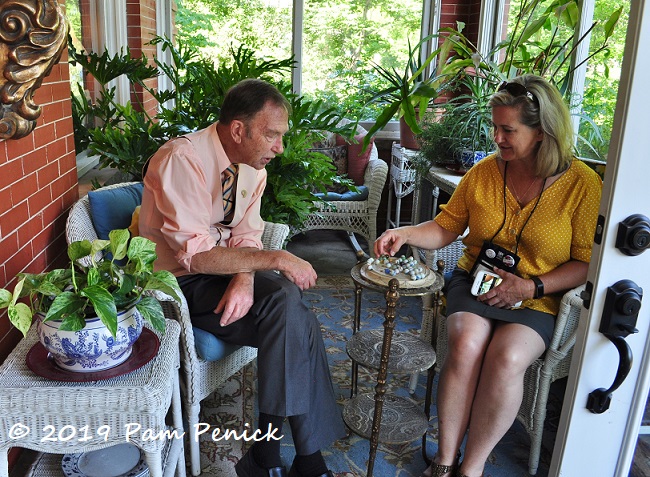
Rob Proctor has been showing Coloradans how to garden for decades. A former director of horticulture at Denver Botanic Gardens and the author of 17 gardening books, he also appears weekly on Denver’s channel 9 news for a gardening segment called “Proctor’s Garden.” When we arrived at his personal garden on Day 3 of the Denver Garden Bloggers Fling (June 2019), I found Rob and Fling planner Judy Seaborn on the front porch, seemingly rapt over a game of marbles, a surprising but charming sight.
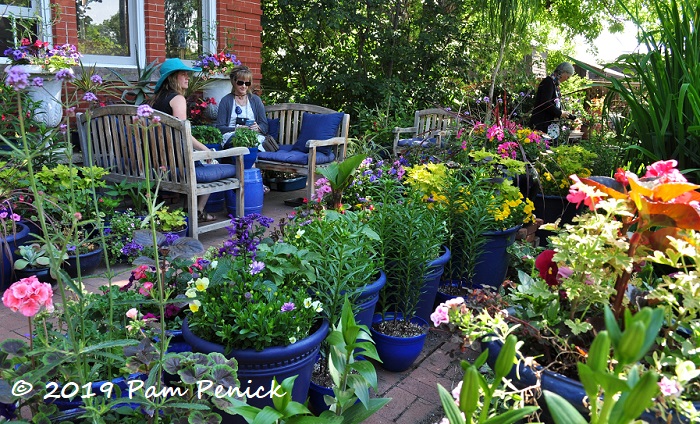
We trooped single file through Rob’s 114-year-old home and stepped out onto a fiesta-colorful patio packed with what looked like hundreds of blue pots of flowering annuals, perennials, and tropicals. All together Rob has stuffed 600+ containers into this and other color-themed patios in his 1/3-acre garden.
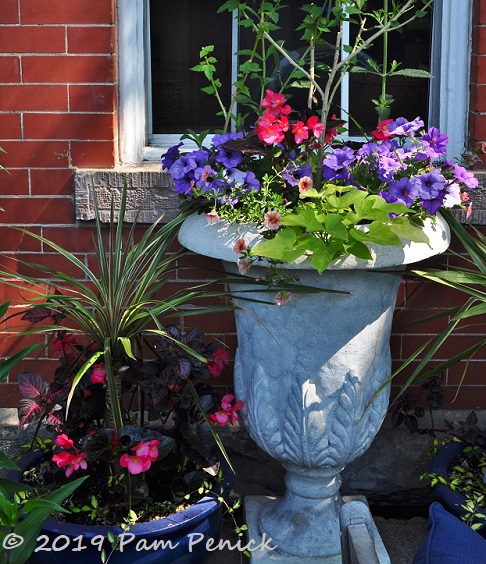
That’s a lot of summer color — and a lot of hand watering! Unless he has them on a drip system. I didn’t notice one, but there was a lot to take in!
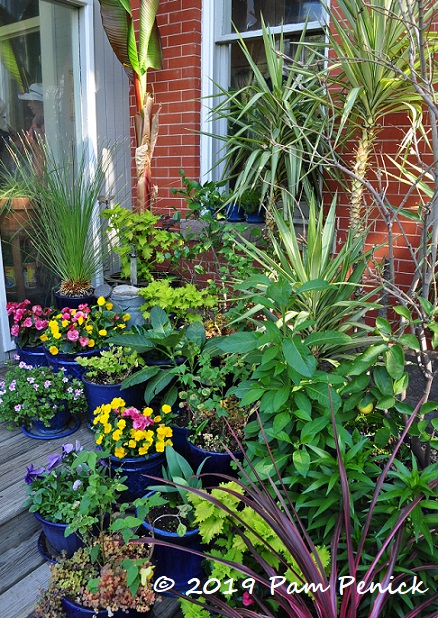
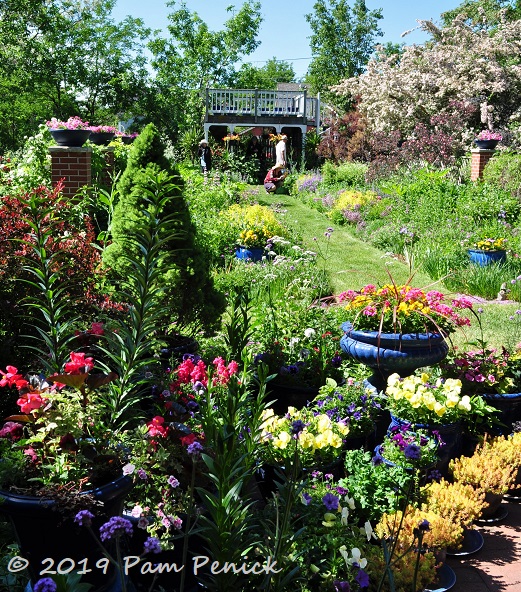
An English-style border stretches from the house toward a gazebo with a rooftop deck, which Rob calls his garden folly. A mown path leads through deep perennial beds defined by brick pillars connected by lattice.
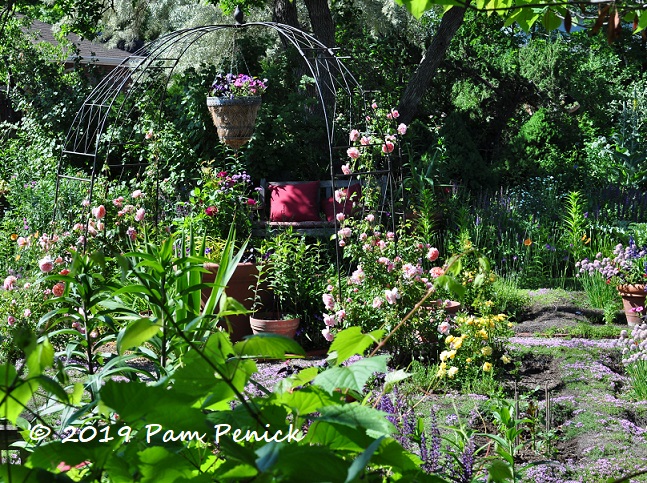
To the left of that main axis, another garden room centers on a rose trellis.
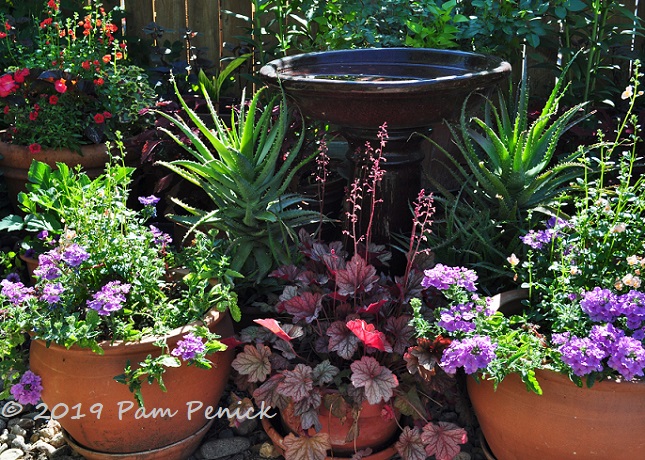
Charming vignettes of potted plants, birdbaths, benches, and garden art attract the eye along a long path — originally a gravel driveway — on the left side of the garden.
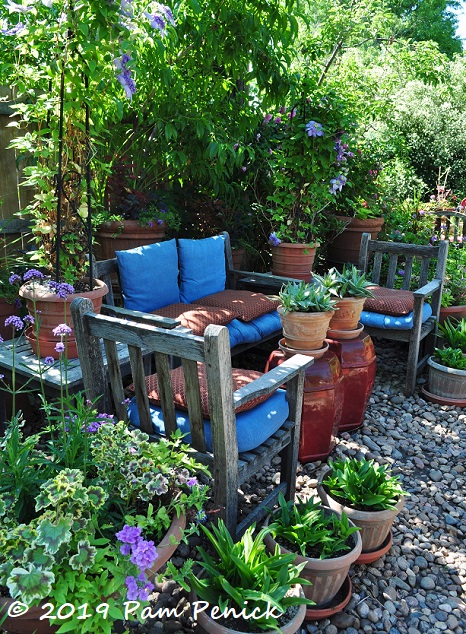
Rob has made color-themed sitting areas along the way, like this pretty blue-and-terracotta grouping. A vertical view shows a clematis arching over the loveseat.
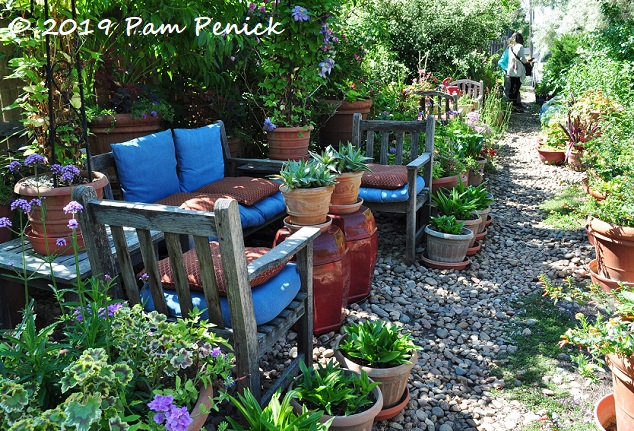
A horizontal view shows the long gravel walk. Rob converted the old driveway into garden rooms with the addition of furniture groupings and tons of containers.
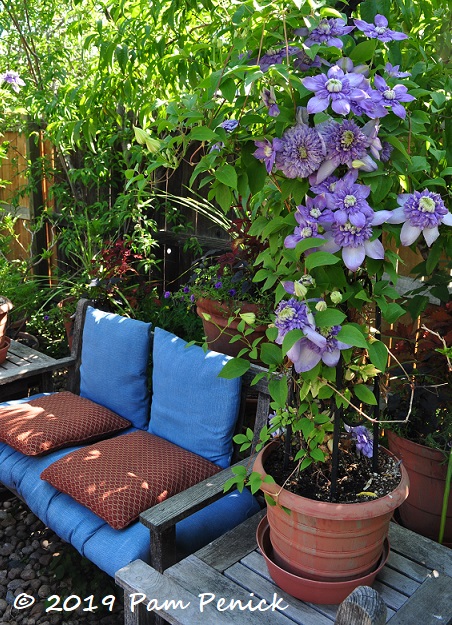
Even the vines are potted.
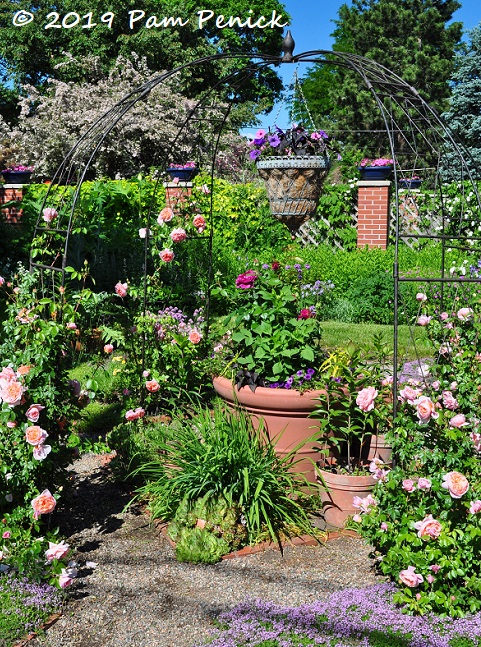
A side view of that rose trellis, with a secondary lawn path in the background. The main lawn path is beyond the pillar fencing.
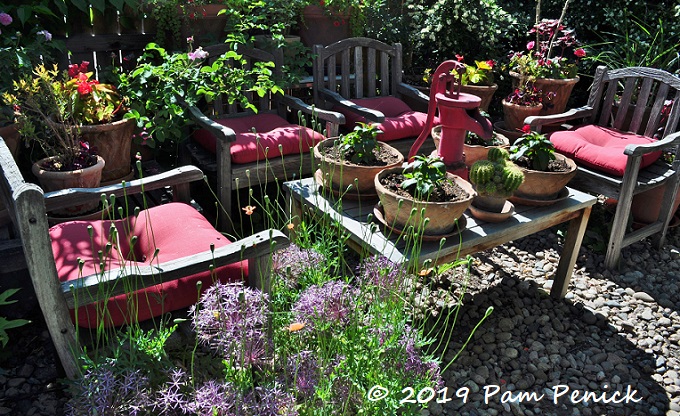
A red patio feels hotter with red flowers and cushions and cactus on the table.
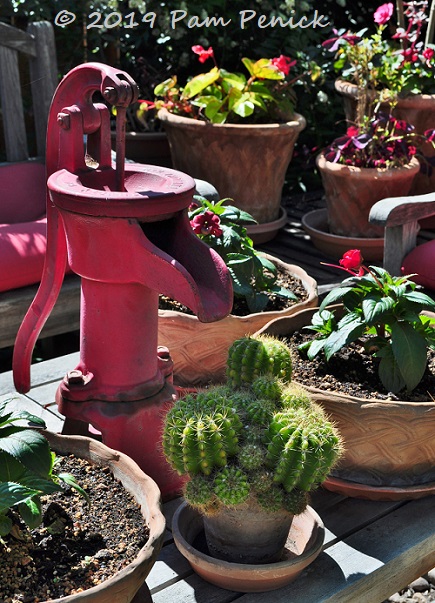
This vignette made me smile: a red water pump (dry, of course) positioned over a water-thrifty cactus.
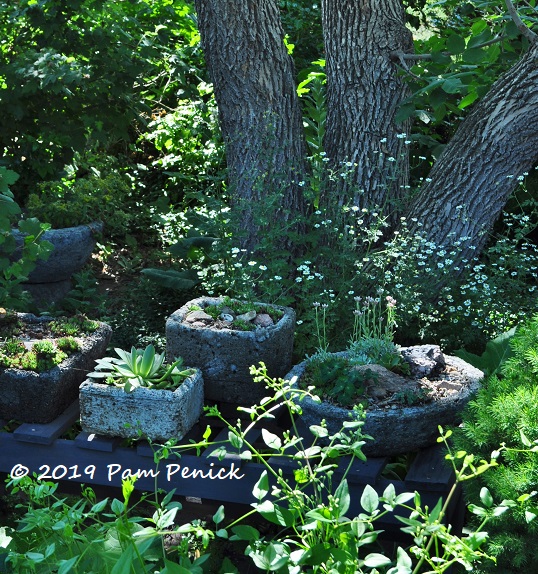
In the shade of a tree along the path, hypertufa pots filled with succulents and alpine plants are clustered on a bench.
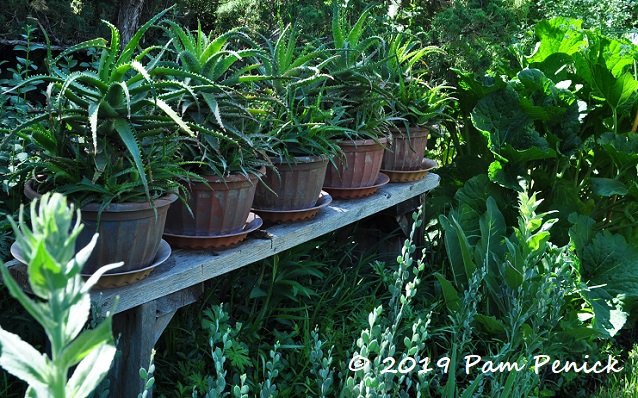
A collection of identical aloes too
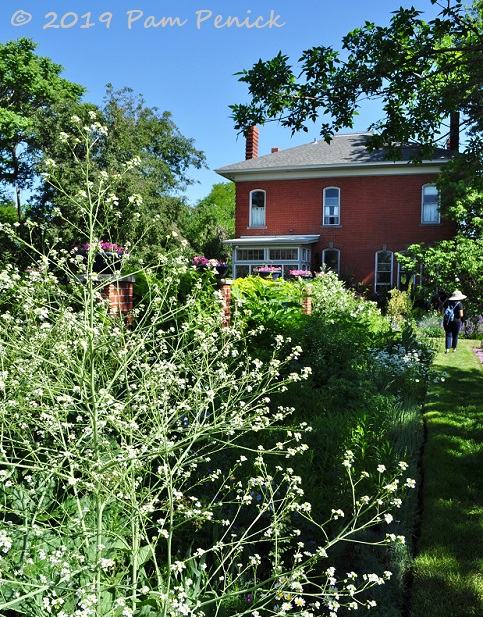
Looking back toward the house from the secondary lawn path
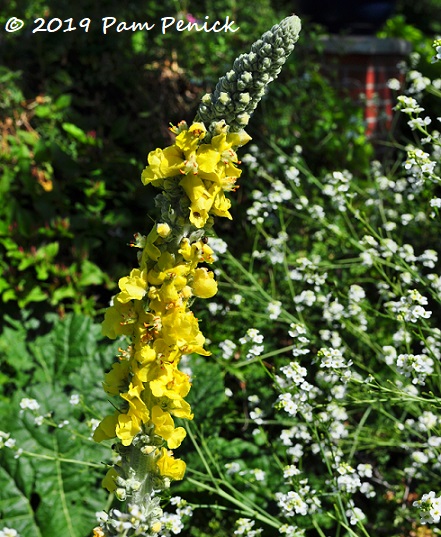
Mullein flower
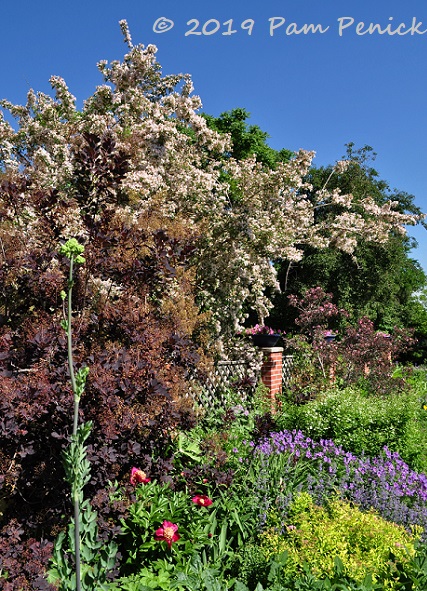
A smoke tree and towering weigela add height and a certain fluffiness.
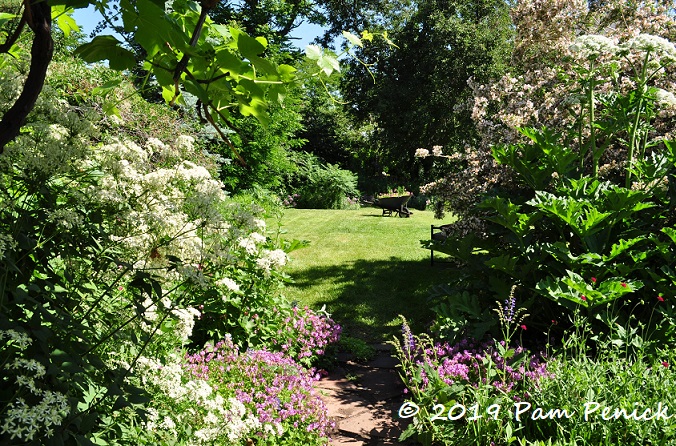
I love this framed view of a lawn and a wheelbarrow planted with flowering annuals, which appear on the right side of the garden.
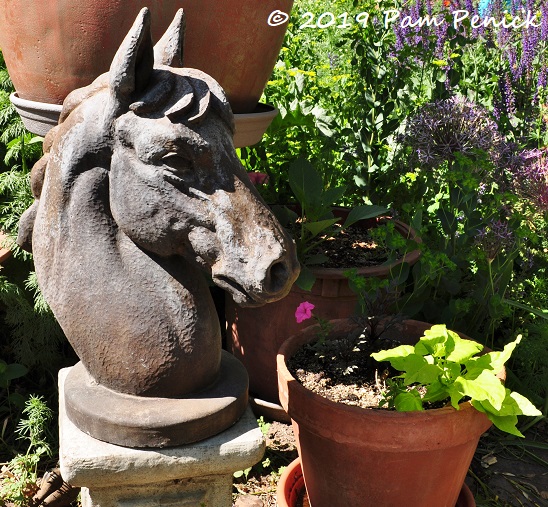
A horse head statuette amid a cluster of potted plants
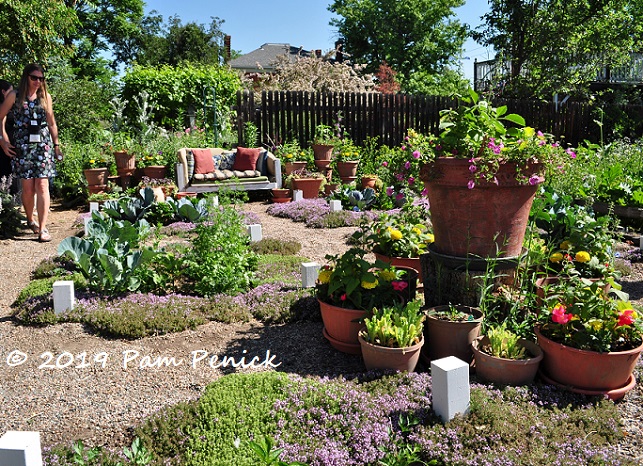
At the back of the garden, a vegetable garden is planted in sunken grids that collect water — an “ancient technology by the Native Peoples,” says Rob, and the polar opposite of planting “high and dry” like gardeners do in wetter climates. “The ‘waffle’ beds are sunk below grade to collect water the way the indentations in waffles collect syrup.” This is smart waterwise gardening in arid climates like Denver’s.
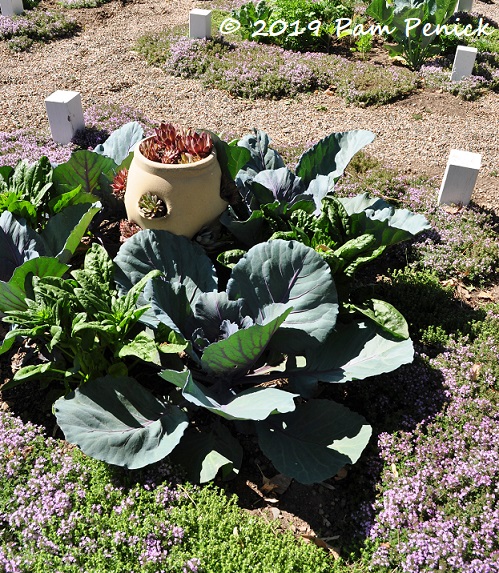
Plants in one of the waffle-like indentations
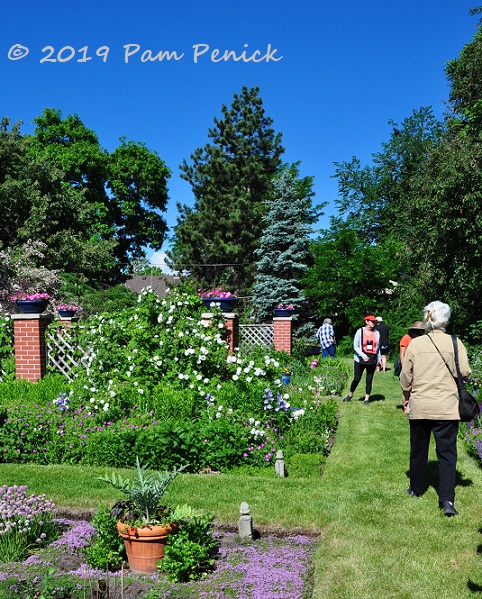
Closer to the house, another waffle-style planting bed contains herbs.
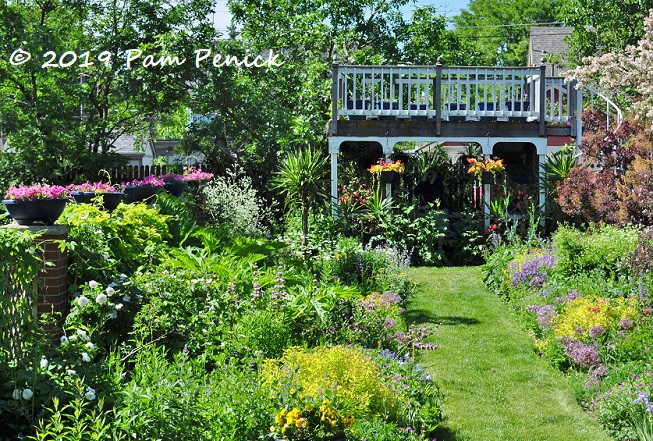
Rob sketched the garden’s design on a cocktail napkin 25 years ago, the day he and his partner, David Macke, celebrated the purchase of their new old home. From a cocktail napkin sketch to the exuberant garden of today, all it takes is a willingness to start digging.
Up next: Jim Borland’s unirrigated garden of dryland native plants. For a look back at the Hamlings’ inviting patio garden, click here.
__________________________
Digging Deeper
Come learn about gardening and design at Garden Spark! I organize in-person talks by inspiring designers, landscape architects, authors, and gardeners a few times a year in Austin. These are limited-attendance events that sell out quickly, so join the Garden Spark email list to be notified in advance; simply click this link and ask to be added. Season 8 kicks off in fall 2024. Stay tuned for more info!
All material © 2025 by Pam Penick for Digging. Unauthorized reproduction prohibited.


:: From a cocktail napkin sketch to the exuberant garden of today, all it takes is a willingness to start digging. ::
…and keep on watering. It’s inconceivable to me that they hand-water all those containers, so various yet all looking at their peak, but maybe so. Slaves to the goddess Flora indeed!
The sunken beds, inspired by Native agriculture, are a surprise in this ornamentally focused garden, but unsurprisingly are themselves decorative. I’ve previously seen the system used only in permaculture or production gardens in arid areas.
I can’t imagine how much time it would take to hand-water all those containers either, especially in such a dry climate. So maybe he does have them on a drip system. I wish I’d gotten a few photos of Rob’s front garden, which was completely different in style and plant choices from the lush, English-style back garden. It was a narrow strip along the front of his house and very xeric-looking. In the context of that garden, his sunken “waffle” beds that are designed to hold onto rainfall make a lot more sense.
Pretty sure he hand-waters. He mentions that in one of his books–it’s a meditative exercise.
Thanks for the info, Astra. And wow.
My brain temporarily short-circuited at the mention of 600+ pots. I liked all the clever ornamental touches here and the riot of floral color of course. I’m going to see if I can use that waffle planting technique somewhere in my own garden too.
I’d not seen waffle-style planting beds before, but it makes a lot of sense. In a similar vein, I’ve long admired the sunken-garden, rainwater-harvesting approach of Tucson designer Brad Lancaster. https://www.harvestingrainwater.com/
One of the lessons most forcefully brought home by photos from the Colorado Fling is the calming power of identical containers and/or plants, lined up. Like the row of tall black pots in the Shinn side garden, those aloes in the Proctor-Macke garden are a huge relief from surrounding busy-ness.
The underlying design of this garden (the cocktail napkin, so to speak) is very appealing, and makes the most out of a not-at-all huge space. But it really would benefit from some stripping-down and simplification — still lush, but more restful. Clearly, though, rest is not the top priority for the owners, and it’s a lovely place to visit.
I think you’re right that rest is not a priority for Rob, not with all those pots to water! And you’ve made a nice observation about the power of lining up identical pots. There’s a row of black pots in Judy’s garden too, along her bocce court. Creating rhythm is always an eye-catching and powerful design move.
I’ve toured Rob’s garden and it’s much more restful in person, I think. Still exuberant but not overwhelming.
MMmmmm I like waffles, oh yes and plants. 600 containers! Now that is an obsession. Did it sort of make you want to count?? I love the folly.
No, I was not tempted to count them. The bus would have left me behind! 😉
What an amazing garden! It was so very English in its feel. I loved the tall walls that ran the length of the garden defining the space. It is a perfect setting for a garden party!
Yes, and croquet!